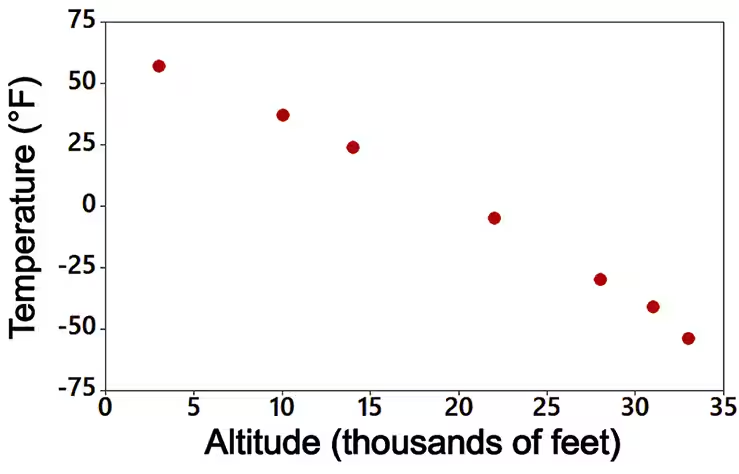Table of contents
- 1. Intro to Stats and Collecting Data55m
- 2. Describing Data with Tables and Graphs1h 55m
- 3. Describing Data Numerically1h 45m
- 4. Probability2h 16m
- 5. Binomial Distribution & Discrete Random Variables2h 33m
- 6. Normal Distribution and Continuous Random Variables1h 38m
- 7. Sampling Distributions & Confidence Intervals: Mean1h 3m
- 8. Sampling Distributions & Confidence Intervals: Proportion1h 12m
- 9. Hypothesis Testing for One Sample1h 1m
- 10. Hypothesis Testing for Two Samples2h 8m
- 11. Correlation48m
- 12. Regression1h 4m
- 13. Chi-Square Tests & Goodness of Fit1h 20m
- 14. ANOVA1h 0m
11. Correlation
Correlation Coefficient
Problem 13.6.5
Textbook Question
In Exercises 5 and 6, use the scatterplot to find the value of the rank correlation coefficient and the critical values corresponding to a 0.05 significance level used to test the null hypothesis of . Determine whether there is a correlation.
Altitude and Temperature Shown below is a scatterplot of altitudes (thousands of feet) and outside air temperatures (degrees Fahrenheit) recorded by the author during a Delta flight from New Orleans to Atlanta.

 Verified step by step guidance
Verified step by step guidance1
Step 1: Understand the problem. The goal is to calculate the rank correlation coefficient (Spearman's rho) for the given data and compare it to the critical value at a 0.05 significance level to determine if there is a significant correlation between altitude and temperature.
Step 2: Rank the data. Assign ranks to the altitude values and the corresponding temperature values. If there are tied values, assign the average rank to the tied values.
Step 3: Calculate the difference in ranks (d) for each pair of altitude and temperature. Then, square these differences (d^2) for each pair.
Step 4: Use the formula for Spearman's rank correlation coefficient: , where n is the number of data points.
Step 5: Compare the calculated rank correlation coefficient (ęŽ) to the critical value for a 0.05 significance level. If |ęŽ| is greater than the critical value, reject the null hypothesis and conclude that there is a significant correlation. Otherwise, fail to reject the null hypothesis.
 Verified video answer for a similar problem:
Verified video answer for a similar problem:This video solution was recommended by our tutors as helpful for the problem above
Video duration:
2mPlay a video:
Was this helpful?
Key Concepts
Here are the essential concepts you must grasp in order to answer the question correctly.
Rank Correlation Coefficient
The rank correlation coefficient, often denoted as Spearman's rho, measures the strength and direction of the association between two ranked variables. It assesses how well the relationship between the variables can be described using a monotonic function. A value close to +1 indicates a strong positive correlation, while a value close to -1 indicates a strong negative correlation. In this context, it will help determine the correlation between altitude and temperature.
Recommended video:
Guided course

Correlation Coefficient
Null Hypothesis
The null hypothesis is a statement that there is no effect or no relationship between two measured phenomena. In this case, it posits that there is no correlation between altitude and temperature. Testing this hypothesis involves statistical methods to determine if observed data significantly deviates from what would be expected under the null hypothesis, often using a significance level, such as 0.05, to assess the results.
Recommended video:
Guided course

Step 1: Write Hypotheses
Critical Values
Critical values are the threshold points that define the boundaries for rejecting the null hypothesis in hypothesis testing. They are determined based on the significance level (e.g., 0.05) and the distribution of the test statistic. If the calculated test statistic exceeds the critical value, the null hypothesis can be rejected, indicating a statistically significant correlation. In this scenario, critical values will help assess whether the correlation between altitude and temperature is significant.
Recommended video:

Critical Values: t-Distribution

 5:43m
5:43mWatch next
Master Correlation Coefficient with a bite sized video explanation from Patrick
Start learning


